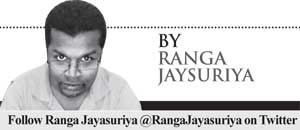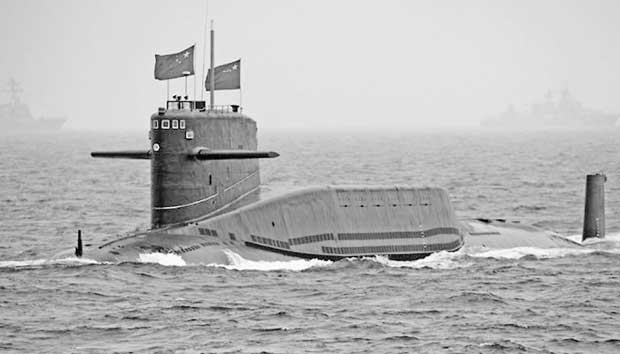Reply To:
Name - Reply Comment
 Why India is misreading Chinese intentions in Sri Lanka
Why India is misreading Chinese intentions in Sri Lanka Quite predictably, New Delhi raised concerns after a Chinese submarine and a support vessel docked at the Colombo Port on October 31 in a second such visit by the PLA (Navy) submarines in two months. The two vessels, a Song-Class submarine Changzheng-2 and a Submarine Support Vessel Chang Xing Duo (Chan Xing Sea) docked at the port for five days for refuelling and crew refreshment and left later last week. They were returning from anti-piracy operations in the Gulf of Aden.
 arlier, another Chinese submarine, a long-range deployment vehicle, which was on its way to the Gulf of Aden, docked at the Colombo Port, a day before the Sri Lankan visit by Chinese President Xi Jinping. It was the first port call made by a Chinese submarine in the Indian Ocean region and rang alarm bells in New Delhi.
arlier, another Chinese submarine, a long-range deployment vehicle, which was on its way to the Gulf of Aden, docked at the Colombo Port, a day before the Sri Lankan visit by Chinese President Xi Jinping. It was the first port call made by a Chinese submarine in the Indian Ocean region and rang alarm bells in New Delhi.
Defence Secretary Gotabaya Rajapaksa who visited Delhi was told by the Indian National Security Adviser Ajit Doval that the docking of the Chinese submarines at the Colombo port was “inimical” to India’s interests, the Times of India reported.
None of those concerns of the Indian establishment has been raised in public (obviously not in any news conferences). New Delhi, on its part, prefers to engage in its quiet diplomacy with Colombo. The question however is not whether the Indians are concerned, obviously, they are but rather, how far New Delhi views the new development as a threat to its interests in its sphere of influence.
"To unpack its full potential, India should embark on bold economic reforms, for which many have pinned hopes on Prime Minister Modi. Failure to reform, would procrastinate India’s relative weakness vis a vis China. A weak India has implications far beyond its borders. It simply dampens the allure of democracy at a time China’s authoritarian model proves that it is capable of creating wealth. That poses a challenge far greater than the perceived threat posed by the Chinese submarines in the Colombo port"
Since its independence, India’s defence realists have adopted their own Monroe doctrine. They carved out South Asia and the Indian Ocean region as New Delhi’s sphere of influence and fought tooth and nail to keep other global powers away. One main reason for India’s decision to destabilize Sri Lanka in the 80’s was the then J R Jayawardene-administration’s tilt towards Washington. New Delhi remained a main non-Warsaw bloc ally of the Soviet Union until the collapse of the communist empire. Some of the Indian concerns that led to its intervention in Sri Lanka, such as the possible leasing of the Trincomalee oil tank farm to the United States and a setting up of the Voice of America Radio Station in Iranamadu were later addressed in the Indo-Lanka Peace accord, which brought an end to the Indian support to Tamil separatist groups. Some Indian observers have now alleged that the visits of Chinese submarines at the Colombo Port are violating the spirit of the 1987 accord. In an exchange of letters between the two heads of states as part of the Indo-Lanka Accord, Sri Lanka agreed that “Trincomalee or any other port would not be made available for the military use of any country in a manner prejudicial to India’s interests.”

The Indian reaction towards the Chinese is a text book case of the realist theory of international relations. Realists claim that states are rational egoists whose primary objective is survival. Since the ordering system of the international system is anarchy, which means that there is no central authority or a world government over the sovereign states, as states function within a self-help system -- meaning that they should look after their interests on their own. And, states are closely observing the behaviour of other states and depending on the changes in the power of the other, each makes adjustments on its own power (primarily its military power). To offer a different analogy; states behave in the international system, pretty much the same way that competitive firms act in a modern market. Their failure to make adjustments, could well send firms into bankruptcy, likewise, the failure of the states to make adjustments in relations to the changes in the relative power of its counterparts would be costly (though only few states have lost their existence by playing blind to those systemic signals, many have suffered badly)
So as the rising China is expanding its reach to India’s backyard and beyond, New Delhi’s sensitivities are understandable.
In fact, its submarine fleet and increasing naval power are at the core of China’s offensive capability. According to a recent study by RAND, the Chinese submarine fleet would increase up to 75 by 2020, making it impossible for the United States to defend Taiwan in a future conflict.
In fact, in terms of naval capabilities, as well as in the other arms of defence, India is lagging far behind China. (China has 58 submarines, including five nuclear-powered against India’s 13, including a nuclear powered one. China has 75 warships, including one aircraft career against India’s 30 ships and two aircraft careers).
The controversy over the visit of their submarines took Beijing by surprise. The Chinese have expected that their role in anti-piracy operation would be touted by the other great powers as a display of China’s willingness to take more global responsibilities, commensurate to its growing size. Since 2008, Chinese worships have escorted more than 5,400 vessels, and thwarted more than 30 potential pirate attacks and rescued more than 40 commercial ships, according to Chinese state media.
Also, anti-piracy operations, the first major blue water naval deployment of PLA (N) have helped the Chinese navy’s transition to a professional blue water navy. During the past five years, it has inducted 15,000 sailors in its anti-piracy missions. For many of them, it was their first long-term naval deployment.
After Indian media made catcalls, the Chinese Defence Ministry defended the port visits, describing them as ‘a common practice by navies of all countries’.
And, Sri Lankan Navy Spokesman Kosala Warnakulasuriya was also quoted (in other media reports) as saying that over 230 warships from various countries have made port calls in Sri Lanka since 2010.
There, realist theory may fall short of explaining the ambiguity of India’s concerns. But, another school of thought -- constructivism, would explain India’s perceptions (or misconceptions) on the perceived ‘Chinese threat.’ States, like people react to other states, depending on the meaning they have for their counterparts. (In other words, as a pioneering constructivist, Alexander Wendt called it in a path breaking essay as ‘anarchy is what states make of it’.) That is why Japan, South Korea, or any other democracy is at its toes over the single nuclear bomb that North Korea has in its arsenal, though they are perfectly comfortable with over several thousands of nuclear warheads that are in the US armoury. That is also why India, which views China as its regional rival, is hypersensitive towards Chinese vessels, though New Delhi may have little reservations about Russian or Turkish or Iranian ships visiting the Colombo Port.
However, the very ideological bias could well lead India to misread Chinese intentions in Sri Lanka and beyond.
There is an emerging consensus that the Chinese presence in Sri Lanka is mainly commercial, a fact increasingly being agreed upon by many observers in New Delhi. However a port call by a diesel- powered Chinese sub at the country’s main commercial port would make the hawks in Delhi to read military objectives in China’s presence in Sri Lanka.
To make matters worse, Indian geopolitical concerns are being aggravated by India’s relative weakness vis a vis China. Today, China’s Gross Domestic Product is more than four times that of India’s (US$9.2 trillion vs. $1.87 trillion in 2013) An average Chinese is two times richer than his Indian counterpart in GDP purchasing power parity. (China’s per capita income is US$11,800 People’s Power Parity (PPP) against India’s US$ 5,500 PPP) In nominal GDP terms, Chinese per capita income is four times than that of India.
In terms of military power, China’s official defence budget is US$131billion against India’s US$38 billion. (Those numbers however do not rule out India’s inherent advantage as a democracy in terms of forming alliances with other liberal great powers to balance against China.)
In 1980, China’s per capita income was US$193, which was far behind India US$275. (World Bank) Since then, China, which implemented the first set of economic reforms in 1978, grew at an annual average of 10 per cent, and this year it overtook the US as the world’s largest economy, measured in PPP though its suitability to gauge the relative power of great powers is open to question.
In the meantime, since its independence, India has been handicapped by its licence Rajas and its own failure to liberalize the economy. Usually, states emulate the best practices of their counterparts. Whereas despite the persistent failure of its economic policy, of which dismal performance is registered in India’s infamous Hindu growth rates, New Delhi continued with the same myopic protectionist policies and bureaucratic red tapes. As recently as 2012, it abandoned a landmark bill to liberalize retail sale, after protests by left parties in the then Congress government and on another instance, it snubbed a ground breaking civil nuclear agreement with the United States, by passing an expensive nuclear liability law.
All the above mistakes have made India weaker. Whereas, since 1980, China, uplifted 400 million people from poverty, not by the virtues of Maoism, (whose rule, in fact, killed more people during the Great Leap Forward, than the numbers killed by the marauding Japanese imperial army during World War II) but through the sheer force of market capitalism.
Differential growth rates of India and China have now created a contrasting picture. Today, the relative distribution of economic power between India and China is more lopsided than that between the US and the Soviet Union during the cold war. During its heydays, the Soviet economy was half of its cold war rival.
To unpack its full potential, India should embark on bold economic reforms, for which many have pinned hopes on Prime Minister Modi. Failure to reform, would procrastinate India’s relative weakness vis a vis China. A weak India has implications far beyond its borders. It simply dampens the allure of democracy at a time China’s authoritarian model proves that it is capable of creating wealth. That poses a challenge far greater than the perceived threat posed by the Chinese submarines in the Colombo port.
Sri Lanka also has lessons to learn. First, what we are witnessing is the unfolding of a great power rivalry, which is still at its incipient stage. Both, China and India have extended financial resources to Sri Lanka; however, the country should desist from the temptation to play a ‘great game.’ Such misadventures were fraught with danger in the past.
"Since its independence, India’s defence realists have adopted their own Monroe doctrine. They carved out South Asia and the Indian Ocean region as New Delhi’s sphere of influence and fought tooth and nail to keep other global powers away. One main reason for India’s decision to destabilize Sri Lanka in the 80’s was the then J R Jayawardene-administration’s tilt towards Washington. "
Second; in the international system, small states are constrained and their influence is extremely limited; surely they don’t have the luxury for self-aggrandizement in the matters where great powers consider their interests are at stake. Thucydides’ description of Melian dialogue remains more or less relevant in the international system even 2000 years later.
Third; countries big and small are learning from their histories. The most important foreign policy lesson in the recent Sri Lankan history is the heavy price we paid for JR’s defiance to New Delhi. Had it not been for that fatal mistake, Sri Lanka would have been a different place.
Fourth; India may be crying ‘wolf’ over Chinese submarines and its concerns may be far from reality. However, Sri Lanka has no option but to attend to them. Sri Lanka has to adjust its behaviour, based on the signals emanating from New Delhi. It has to comply with them. For the average folks on the streets that may sound slavish. But, that would be in the self-interest of Sri Lanka. After all, that is exactly what a rational state actor would do to ensure its survival.